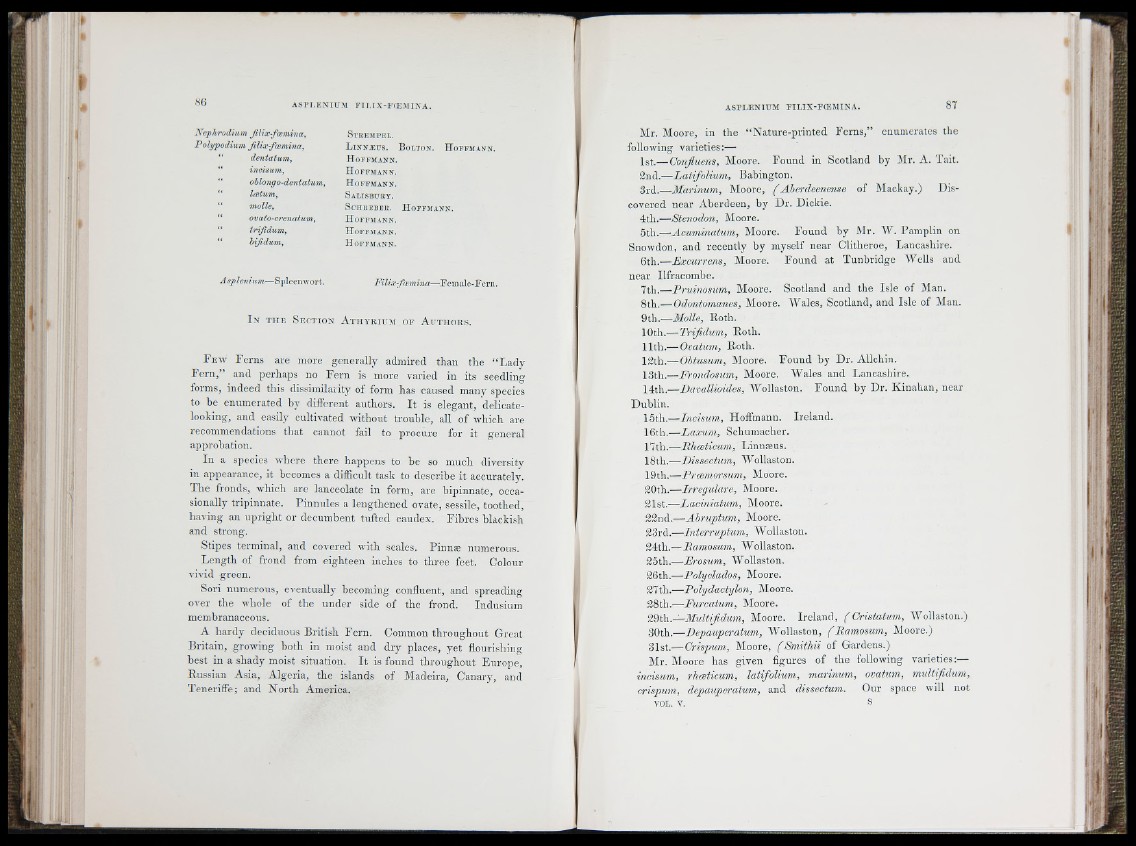
I ’!, \
|tM
Xcpht'OiHum Jtlix-fismina,
Polypodium fdix-foemina,
“ deniatum,
“ incisum,
“ ohlongo-dentatum,
“ lætum,
“ molle,
“ ovaio-crenatum,
“ irifidum,
“ hifidum.
Stuempel.
L innæcs. Bolton. H offmann.
H offmann.
H offmann.
H offmann.
Salisbury.
S chreber. H offmann.
IIOFFM.ANN.
H offmann.
H offmann.
Asplenium—Spleenwort. Pilixfoemina—Fenialc-Fern.
ÏN* THE S ection Athyrium of A n
F ew Ferns are more generally admired than the “ Lady
Fern,” and jierhaijs no Fern is more i-aried in its seedling
lorms, indeed this dissimilarity of form has caused many species
to be enumerated by different authors. It is elegant, delicate-
looking, and easily cultivated without trouble, all of which are
recommendations that cannot fail to procure for it general
apjrrobation.
In a species where there happens to he so much diversity
in appearance, it becomes a difficult task to describe it accurately.
The fronds, which are lanceolate in form, are bipinnate, occasionally
tripinnate. Pinnules a lengthened ovate, sessile, toothed,
having an upright or decumbent tufted caudex. Fibres blackish
and strong.
Stipes terminal, and covered with scales. Pinnæ numerous.
Length of frond from eighteen inches to three feet. Colour
vivid green.
Sori numerous, eventually becoming confluent, and spreading
over the whole of the under side of the frond. Indusium
membranaceous.
A hardy deciduous British Fern. Common throughout Great
Britain, growing both in moist and dry places, yet flourishing
best in a shady moist situation. It is found throughout Europe,
Russian Asia, Algeria, the islands of Madeira, Canary, and
Teneriffe; and North America.
Mr. Moore, in the “Nature-printed Ferns,” enumerates the
following varieties:—
1st.— Confluens, Moore. Found in Scotland by Mr. A. Tait.
2nd.—Latifolium, Babington.
3rd.—Marinum, Moore, ( Aherdeenense of Mackay.) Discovered
near Aberdeen, by Dr. Dickie.
4th.—Stenodon, Moore.
Acuminatum, Moore. Found by Mr. W. Pamplin on
Snowdon, and recently by myself near Clitlieroe, Lancashire.
6th.—Excurrens, Moore. Pound at Tunbridge Wells and
near Ilfracombe.
7th.—Pruinosum, Moore. Scotland and the Isle of Man.
8th.— Odontomanes, Moore. Wales, Scotland, and Isle of Man.
9th..—MoUe, Both.
10th.— Trifidum, Both.
11th.— Ocahim, Both.
12th.— Ohtusum, Moore. Found by Dr. Allchin.
13th.—Frondosum, Moore. Wales and Lancashire.
14th.—Daiallioides, Wollaston. Found by Dr. Kinahan, near
Dublin.
15th.—Incisum, Hoffmann. Ireland.
16th.—Laxum, Schumacher.
17th,—Ithæticum, Linnæus.
18th.— Dissectum, Wollaston.
19th.—Præmorsum, Moore.
20th.—Irreguläre, Moore.
21st.—Laciniatum, Moore.
22nd.—Ahruptum, Moore.
23rd.—Interruptum, M ollaston.
24th.—liamosum, Wollaston.
25th.—Erosum, Wollaston.
26th.—-Polyclados, Moore.
27th.— Polydachjlon, Moore.
28th.—Furcatum, Moore.
‘g.Qih.—Midtifidum, Moore. Ireland, f Cristatum, Wollaston.)
30th.— Depauperatum, Wollaston, fRamosum, Moore.)
31st.— Crispum, Moore, ( Smithii of Gardens.)
Mr. Moore has given figures of the following varieties:—
incisum, rhæticum, latifolium, marinum, otatum, multfidmn,
crispum, depauperatum, and dissectum. Our space will not
TOL. V. S
u i i